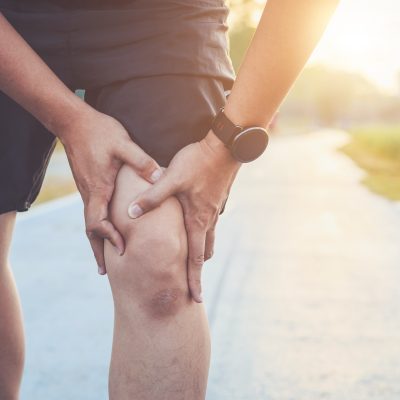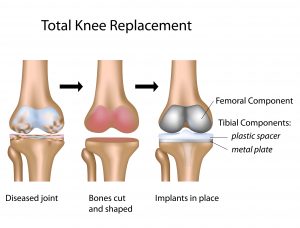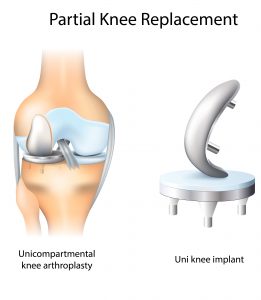Knee Pain
Our Team Can Help
Knee pain can impact everyone, regardless of age or health. Your knee pain can hold you back from everyday activities or participating in the sports and activities you enjoy. Knee pain is very common and can result from an injury, such as torn cartilage or ruptured ligament. ACL injury, torn meniscus, knee bursitis, fractures and patellar tendinitis are all very common knee injuries. Infections or arthritis are medical conditions that can cause knee pain.
Knee Injuries and Pain
- ACL Injuries
- Knee Arthritis
- Knee Ligament Injuries
- Meniscus Tears
- Osgood-Schlatter Disease
- Patellar Dislocation
- Runner’s Knee
Symptoms Include:
- Pain
- Crunching or popping noises
- Redness or swelling
- Struggle to fully straighten the knee
- Weakness or inability to bear weight on your knee
How is Knee Pain Treated?
Knee pain requires a thorough assessment from our orthopedic experts. This could include tests, such as x-ray, CT scan, ultrasound or MRI. If an infection or inflammation is at the source of your pain, a blood test or arthrocentesis procedure may be performed to remove a small amount of fluid for laboratory analysis.
- Non-surgical treatment options include: therapy to help strengthen the muscles around the knee, or injections to help relieve your knee pain.
- Your injury or condition may require surgery if non-surgical techniques fail to provide relief. Your orthopedic provider will discuss the best treatment options with you.
Viscosupplementation Injections (“gel shots”)
Reduce Knee Pain
Orthopedic providers use these shots to inject a gel-like fluid called hyaluronic acid (HA) into your knee joint to reduce pain
- How does it work? Synovial fluid is an important part of joint health, acting as a cushion for the bone and cartilage. A lack of synovial fluid can contribute to discomfort and joint pain. Viscosupplementation injections (gel shots) can replace some of the lost synovial fluid by injecting artificial hyaluronic acid – a component of synovial fluid – into a knee joint. This gel acts as “a lubricant” and restores the smooth movement of the cartilage covering the surfaces of the joints.
- Who is a candidate? Patients with knee osteoarthritis who are not responding to non-surgical treatment options such as pain medications, physical therapy and corticosteroid injections are candidates for viscosupplementation injections.
- How long does it last? Gel shots will provide symptomatic relief and potentially delay the need for surgery. How long the effects last depends on your condition. Gel shots generally last from 6 to 12 months.
- What to expect during the procedure? Depending on the brand of gel shot, you may have one injection per week or multiple injections in a week. The injection only takes a few minutes to complete. For a knee injection, you will lie down with a straight leg or sit upright with a bent knee based on provider preference on how they intend on injecting your knee. After the knee has been properly sanitized, a local anesthetic will be applied to numb the area. If necessary, the provider may remove any excess fluid from your knee if it is swollen. Once ready, the orthopedic provider will inject the gel by utilizing an ultrasound to ensure that the gel is safely injected directly into the joint. After the injection is complete, the knee is cleaned and bandaged. You will then bend and straighten your knee a few times to spread the medication to the joint.
- What side effects can a patient experience? As with any procedure, side effects may occur. The most common side effects of gel shot knee injections are redness at the injection site, heat, mild pain and swelling. You may also experience itching, rash or bruising around the joint. Talk with your provider about what to expect with viscosupplementation injection treatment.
Knee Surgery
- During a knee arthroscopy, your surgeon will make small incisions around your knee to insert a camera. This minimally invasive approach allows your surgeon to clearly locate and repair damaged cartilage and reconstruct ligaments in your knee.
- Knee replacement surgery involves removing damaged portions of the knee and replacing them with artificial parts called prostheses. Damage is the result of arthritis and/or injury. The decision to have a knee replacement is made with your surgeon and is based on your general medical health and how much your daily life is affected by your knee:
- Pain that affects your activities of daily living, walking or sleeping
- Swelling that does not improve with rest or medications
- Stiffness resulting in inability to bend or straighten the knee
- No improvement with medications, therapy, or knee injections
- Deformity
 Total Knee Replacement (consists of four pieces):
Total Knee Replacement (consists of four pieces):
- Femoral component – metal piece with a groove caps the end of the femur, allowing the kneecap to move up and down as the knee bends and straightens
- Tibial component – flat piece of metal that covers the top of the tibia
- Patellar component – dome shaped piece of plastic that allows patellar replacement to glide smoothly over the new knee (remove period)
- Polyethylene insert – new plastic cartilage
- Partial or Unicompartmental (“UNI”) Knee Replacement

- A unicompartmental knee replacement may be an option when only one compartment of the knee needs to be replaced:
- Medial compartment – inner side
- Lateral compartment – outer side
- Certain other factors need to be considered. Your surgeon will discuss these with you.
Learn more about our team’s positive approach to joint surgery by clicking here.